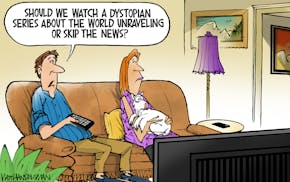Opinion editor's note: Star Tribune Opinion publishes a mix of national and local commentaries online and in print each day. To contribute, click here.
•••
Our urban vitality is precarious. Anyone who would have predicted a decade ago that downtown Minneapolis would lose nearly half of its workers, our transit system nearly half its users and Uptown most of its businesses would have been regarded as nuts. But that's where we are.
The Minneapolis Foundation has issued a voluminous report laying out a prescription for downtown revival. Some of it feels rote, but it's not a bad starting place. It really could use an accompanying action plan. But what's needed even more is a sense of regionwide will.
I've been advocating for our downtowns since the year I moved to the Twin Cities (1981). I've always been puzzled by how many locals don't use them and how their advocates are limited to those who do. It's not that way in the most vibrant American cities, where downtown isn't a triangulation between Republicans who hate the city, leftists who see caring about downtown as some sort of sellout to corporate interests and a narrow cadre who recognize their essentiality.
This year I've been fortunate to travel extensively abroad. London, Dublin, Amsterdam, Tel Aviv, Brisbane and Melbourne, Australia. And after each trip, I come home feeling worse about the place I live.
I find myself asking: What have we done so wrong in this community that public amenities we have spent decades investing in cannot generate consensus? While the world reinhabits its cities and makes up for lost pandemic years, Minneapolis drifts, crowded with excuses.
Until I visited Australia, I pinned our malaise on work from home (WFH), which is justly blamed for emptying out American city centers. But other places have made it work. Few regions locked down harder and longer than the Australian state of Victoria, where WFH is still common. Yet Melbourne earlier this month was buzzing morning till night with holiday revelers and workers packing cafes, shops and streets.
The two large American downtowns showing the worst office vacancy trends and declining real estate values are Minneapolis and Chicago. In Minneapolis, downtown core visits from November to February were 56% of 2019 according to a University of Toronto study, worse than every other large North American metro area save St. Louis. It's hard not to come away with the impression that our local mire is the deepest, perhaps, in the western world.
The Twin Cities are heavily suburbanized. Our urban population is not even a quarter of our metro area, less than 750,000, divided between two downtowns. I have never inferred among suburbanites the sense that the hub of this community is downtown Minneapolis, as it should be. It's certainly the way people in their respective regions regard Chicago, Columbus and Boston.
Our two downtowns have always competed for resources (imbecilic, but seemingly intractable), dividing rather than concentrating the vibrancy. St. Paul has fallen so deep and hard that it's difficult to regard it as a downtown. The decampment of the state government sector — which dominated St. Paul — to permanent WFH has rendered the place like a postapocalyptic soundstage.
The other issue in Minneapolis is crime, or fear of crime, or fear of the fear of crime. No issue has been the subject of as much ideological gaslighting. I'm downtown four to six days each week and I can tell you that it's nowhere near as ominous and fraught as suburbanites and Republicans go on about. But neither is it as benign as the Pollyannas on social media pretend. The sense of jeopardy downtown has been on the upswing for a decade, due to changes in how antisocial behaviors are addressed by law enforcement.
Before you start quoting crime data, it's not about arrest stats. It's about the lack of activity and how that makes people feel isolated and vulnerable.
In Minneapolis, there's no telling when you're going to turn the corner onto a deserted block where a disordered or angry man doesn't like the way you looked at him. Because downtown Minneapolis never was all that lively, the loss of worker critical mass has made a disproportionate impact. Target has been blamed for setting the tone; perhaps if its newly mandated four weeks in-office scheme is staggered smartly, it can make a difference next year.
I'm also disappointed in the city's relentless urbanist community, which has been too frequently silent on downtown's plight. They know all too well that the healthiest cities have thriving centers, places where people of all backgrounds and economic strata gather. They should have been decrying the damage to public transit wrought by the demise of commuting and warning of the risk of destroying downtown's tax base, which funds so much public spending. A failure to reactivate Minneapolis will lead to its tax burden being spread to residences and neighborhood businesses or large-scale cuts in services.
But urbanism today is frequently intertwined with other political orthodoxies and urbanists have had far too little to say, especially regarding any solution that involves improving the public safety climate.
The degradation of our public transit system is the result of a similar kind of gaslighting/neglect, but by the DFL establishment in the Legislature and within the Met Council, who pretended for three years there was no problem on our buses and particularly our trains. They sold out the working class to avoid the opprobrium of loud advocates who believed LRT should be for the unhoused and addicted — that antisocial behaviors should be embraced with empathy by the students, elderly and working poor who rely on transit. Digging Metro Transit out of its current state will take a generation.
And there's the problem of guns. There is no finessing a handgun. The explosion of crimes committed by youth with handguns is undeniable. I assume every man I encounter in an American city is armed. I was struck each time I left the U.S. by how much safer I felt late at night in a foreign downtown. Even Tel Aviv.
In sum, it's hard not to conclude the Twin Cities has been dealt an extraordinarily bad hand. But in the end, there is no one to blame but us. For tolerating a police culture of abuse until it destroyed any possible consensus on public safety, and by forsaking our urban fabric.
My adult son remarked the other day that friends and colleagues who can't afford the North Loop are moving to Chicago because so many of the once desirable parts of Minneapolis no longer feel fun or safe.
I never would have guessed that 2015 was a peak, but more and more I'm convinced I'm living in a region that lacks the energy and will to ever move beyond "meh" on the integrality of downtown life to a successful city.
Adam Platt is executive editor of Twin Cities Business.

BWCA's future likely hinges on election
Saving the dinosaurs: Why there's a future for community newspapers
Readers Write: Gun storage laws, Uber and Lyft, 24/7 businesses, the pipe organ


